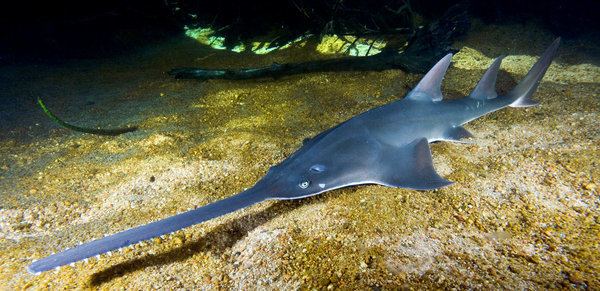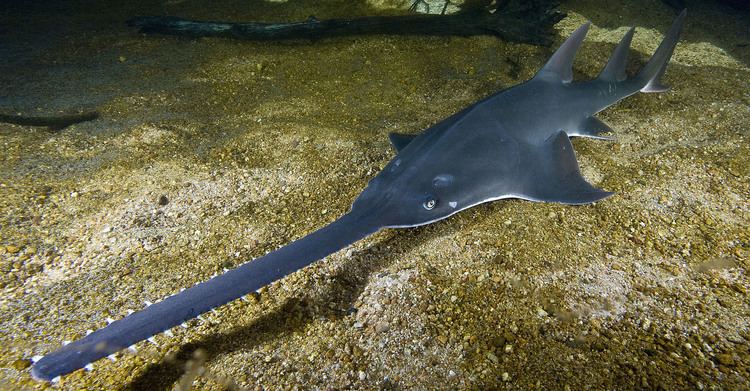Family Pristidae Rank Species | Phylum Chordata Order Pristiformes Genus Pristis Higher classification Pristis | |
 | ||
Similar Sawfish, Largetooth sawfish, Batoids, Common sawfish, Pristis | ||
The smalltooth sawfish (Pristis pectinata), also known as the wide sawfish, is a sawfish of the family Pristidae. It is found in shallow tropical and subtropical waters in coastal parts of the Atlantic, including the Mediterranean. Reports from elsewhere are now believed to be misidentifications of other species of sawfish. This critically endangered species reaches a length of up to 7.6 metres (25 ft).
Contents
- Protecting the smalltooth sawfish
- For feeding
- For defense
- Reproductive behavior
- Conservation status
- References

Protecting the smalltooth sawfish
For feeding

For many years, rarity of seeing a sawfish in the wild prevented scientists from collecting conclusive evidence about the use of their distinctive rostrum. This led them to falsely assume that the sawfish, like many other marine vertebrates with a “beak,” or an elongated rostrum, follow the rule that the appendage is used to either sense prey or capture prey, but never both. There are no other highly studied marine animals with similar rostral characteristics that have shown that the rostrum is used for both of these feeding techniques. Recent studies have demonstrated, however, that the sawfish utilize their rostrum to both sense and manipulate prey.

A sawfish’s saw is made up of thousands of sensory organs that allow them to detect and monitor the movements of other organisms by measuring the electric fields they emit. The sensory organs, also called ampullary pores, are packed most densely on the dorsal side of its beak. This allows the fish to create an image of the three-dimensional area above it, even in waters of low-visibility. This provides support for the bottom-dwelling behavior of sawfish. Utilizing their saw as an extended sensing device, sawfish are able to “view” their entire surroundings by maintaining a position low to the sea floor.

Sawfish uncover sand dwelling crustaceans and mollusks, two common prey types, by using their unique anatomical structure as a tool for digging and grubbing about in sand or mud. The sawfish churn up the sea bottom with their exaggerated rostrum to uncover these hidden food sources.

It is believed that the elongated rostrum first evolved for its use in prey immobilization. Smalltooth sawfish have been observed to approach large shoals of fish while striking their saw rapidly from side to side. Due to the high density of small fish in a shoal, there is a high probability that the sawfish will hit, stab, stun, or kill several prey during one shoal attack. The sawfish has also been observed to attack larger prey by using their weapon to dislodge large pieces of meat from victims. They then use their serrated saw teeth to tear through flesh.

Vertebrate biologist Barbara Wueringer, of the University of Queensland, demonstrated that sawfish use their extended rostrum to detect and manipulate prey. She observed the animals’ reaction to food already at the bottom of the tank, food falling from the water's surface, and introduced electric dipoles. When the sawfish came across scraps of fish resting on the bottom of the tank, it used its rostrum to pin the “prey” down as it swam over and engulfed it. When food was identified as it fell through the water, the sawfish would approach its “prey” from the side and swiftly strike to impale the victim with the teeth of its saw. Both of these cases support the respective digging and attacking behaviors expected from feeding sawfish in the wild. In order to show that sawfish use their beak to sense their surroundings, Wueringer placed electric dipoles throughout the tank to simulate the electrical signals that surround moving prey. Just as the sawfish displayed different aggressive behaviors towards the “prey,” they also responded differently based on the electrical signals they received by either avoiding or approaching the signal source. With this evidence, the sawfish is now regarded as the only jawed fish to use its rostrum for both prey detection and manipulation.
For defense
The many teeth of a sawfish’s saw are not actually teeth at all, but rather special types of scales known a dermal denticles. These protruding weapons, combined with the animal’s ability to strike from side to side with great force, provide it with a powerful and efficient defense mechanism. Although the saw is mainly used for feeding purposes, observations of sawfish in captivity show that they may also be used for self-defense. When sharks or other marine creatures threaten them, they retaliate with three swift blows to the instigator’s dorsum. Sawfish are not considered harmful to humans unless they are threatened.
Reproductive behavior
The reproductive behavior of smalltooth sawfish has not been well studied, despite their classification as a critically endangered species and the dire need for captivity breeding to return the population to its ideal size. Nevertheless, much can be inferred based on information known about the reproductive behavior of other elasmobranchs. Observations show that smalltooth sawfish may participate in precopulatory behavior in captivity. Much of this activity involves the biting of pectoral fins known as “courtship biting.” There is sexual dimorphism in the teeth of smalltooth sawfish, with males presenting a higher mean value for both left and right rostral tooth counts. The electrosensory system is believed to be used in the courtship behavior of sawfish and other elasmobranchs. Reproductively active males use the sensory organs in their saw to locate females and vice versa. Once a mate has been selected, several copulations occur during which the male inserts his claspers, which are paired intromittent organs, into the female’s vagina. The claspers contain subdermal siphon sacs that provide the propulsive power for sperm transfer. It is also possible that the siphon sacs assist with sawfish sperm competition by washing away rival sperm from the female’s vagina before copulations.
Smalltooth sawfish have recently been observed, for the first time, to reproduce parthenogenetically in the wild. About 3 percent of the sawfish living in a Florida estuary are the result of parthenogenesis. The research team speculates that since smalltooth sawfish are so rare, females might sometimes fail to find a male during the mating season, inducing the parthenogenetic process.
Elasmobranchs are ovoviparous, have relatively long gestation periods, and internal fertilization. The sawfish eggs hatch in the uterus and the young continue to grow without a placental connection to the mother. The fetal sawfish receives nourishment from a yolk sac and absorbs all the nutrients it can from the yolk before it is born. Litters have been reported of up to 20 pups and the reproductive cycle is believed to be every two years. After sex, mating pairs separate without forming a pair bond and each continues polygamous matings.
Conservation status
Smalltooth sawfish are extremely vulnerable to overexploitation because of their propensity for entanglement in nets, their restricted habitat, and low rate of population growth. The species is listed as critically endangered by the IUCN Red List. The United States population was listed by the National Marine Fisheries Service as endangered under the Endangered Species Act in 2003. The species is listed on Appendix I of the Convention on International Trade in Endangered Species.
